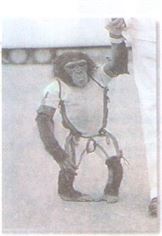fce listening about animal in space
چگونه در آزمون اف سی ای پاسخ یک ایمیل دوستانه را بدهیم

Listening 2
Part 2
Sentence completion 2.42

1 The photograph shows Ham the chimp, who went into space in 1961. What other animals do you know of that have been into space? Why are they sent there?
2 You will hear part of a radio report about animals in space. For questions 1-10, complete the sentences.
Not surprisingly, the use of animals for space research has been unpopular with animal welfare groups ever since it began. Back in 1957, for example, every day that Laika was in space, the National Canine Defence League in Britain asked all dog lovers to observe a one-minute silence. Space scientists have been accused of being cruel to animals and strongly criticized for carrying out their experiments on defenceless creatures. In the meantime, many of the animals themselves have become celebrities. Laika's space flight attracted a huge amount of attention from the world's press, and the dog's image appeared on stamps in a number of countries, including Romania, Poland and Albania. And in 2008, over fifty years after her historic flight, a monument was erected in honour of Laika in Moscow. It features a dog standing on the combination of a rocket and a human hand.
Another animal to achieve celebrity status was Ham, a three-vear-old chimp who was sent into orbit ii-i January 1961 to find out whether humans would be able to survive in space. Originally from Cameroon in Africa, Ham was bought by the United States Air Force and sent to New Mexico, where he was trained for the tasks he would carry out during his space flight. For unlike previous animal astronauts, Ham would be more than just a passive passenger. He was taught, for example, to pull a lever in response to a flashing light; if he did so within five seconds of seeing the light flash, he would receive a reward of food. The purpose was to see how well tasks could be performed in space. During the mission, Ham was weightless for over six minutes. His capsule suffered a drop in oxygen levels but he was safe inside his space suit and sixteen minutes after launching from Cape Canaveral, he splashed down in the Atlantic with nothing more than a bruised nose. When the rescue helicopters eventually got to him, he was rewarded with an apple and half an orange. He had beaten the first man into space, the Russian Yuri Gagarin, by over two months. Afterwards, Ham retired to the US National Zoo in Washington DC, where he was well looked after and enjoyed a celebrity lifestyle. His picture appeared on the cover of Life magazine and he even received fan mail, some of which he replied to by sending admirers his fingerprint. In 1980, a very overweight Ham moved to North Carolina Zoo, where he died three years later.
Animals in space
The first animals to survive a space flight were a pair of (1) .
Able and Baker's spacecraft reached speeds of (2) miles per hour.
One animal welfare group called for a (3) everyday that Laika was in space.
Pictures of Laika appeared on (4) in several countries.
The Laika monument shows a dog on a rocket combined with a (5) For his 1961 space mission, Ham the chimp received training in (6) .
Ham performed tasks in which he responded to a (7) by pulling a lever.
Ham's space flight lasted (8)minutes.
When he was picked up, Ham was given an apple and (9) as a reward.
Ham answered some letters by sending his (10) to fans.
3 How do you feel about animals being sent into space? Why?
Do you object to animals being used in any of the following situations? Why/Why not?
- medical research
- the cosmetics industry
- zoos
- the entertainment industry (circuses, magic shows, films)
Vocabulary 4: Verbs followed by prepositions
1 Complete each gap in this sentence from the listening with an appropriate preposition.
Space scientists have been accusedbeing cruel to animals and strongly criticizedcarrying out their experiments on defenceless creatures.
Check your answers in the listening script on page 238.
2 Match each sentence beginning 1-10 on the left with a suitable ending a-i. Complete each of the gaps with an appropriate preposition.
Example: 1c
1 I'd like to thank you for-C
2 The cyclist blamed me
3 I really must apologize
4 I'm always being told off
5 Sue can't forgive him
6 My parents prevented me
7 To discourage children
8 We congratulated Paul
9 My aunt insisted
10 I can't concentrate
a being late. I'm so sorry to keep you waiting.
b watching the film. They said it was too violent.
c sending me those flowers. It was so kind of you.
d swearing, try fining them for using bad language.
e causing the accident, but it was his fault, not mine.
f driving me home. 'It's too cold to walk,' she said.
g doing my homework with you singing all the time!
h laughing in class. My teachers are far too serious.
i leaving her to bring up the children on her own.
j passing all his exams. He deserved to do well.
3 a Choose four of the sentence beginnings from exercise 2 and write your own ending for each one.
b Read out your endings to your partner, who will try to guess the beginning of each sentence.
4 Talk to your partner about the last time you:
- apologized
- thanked someone
- were congratulated
- couldn't concentrate
- were prevented from doing something
- were told off
writing
Part 2
1 Read the following Wntmg Part 2 instructions and the sample answer. Comment on the following features in the sample answer, giving examples to support your opinion:
Range of language Accuracy Style of the language Relevance Use of paragraphs and linking words Effect on the target reader
You have received an email from your Australian friend, Anna. Read this part of the email and then write your email to Anna.
My last exam is in June and then I'm going to spend a month in your country. You know how much I like being in the countryside - can you recommend a couple of areas where I could go walking and also see some interesting wildlife?
Thanks
Anna
Write your email in 140-190 words.
Hi Anna
You must be mad to want to go walking ! when i finished my exams last year i spent about a week at home doing almost noting. it was great. i stayed in bed all morning , played on the computer all afternoon and then went out in the evening. i got a summer job after that so i could pay for my holiday to creece, where i spent most of the time sunbathing.
Anyway, here are a couple of places you might want to go to during your month here. Firstly, there are the mountains in the north of the country. Lots of people gp there in the summer to get away from the city. personally, i wouldn't want to, because there's nothing to do in the evening, so i'd find it a bit boring -but you might like it.
Secondly, there's the path that goes along the coast in the south. there are no beaches and it can get a bit windy, so it's not my favourite place. But there are some good views from the cliffs, if you like that kind of thing.
Bye
David
2 Write your own answer to the task in exercise 1 in 140-190 words. Use some of the ideas in the Useful language box below.
Useful language
Walking
a lovely/popular/spectacular/superb walking area coasta//forestlmountainlriversidelrocky/steep paths cha/lenginglcircular/gentlelsceniclstrenuous walks breathtaking/magnificent/spectacular/stunning views
Wildlife
It's a great place to see (birds). You might catch sight of (a deer). The area is known for (bears). Keep an eye out for (bats).
People come here to observe (seals).
Read more about writing emails on page 197.


